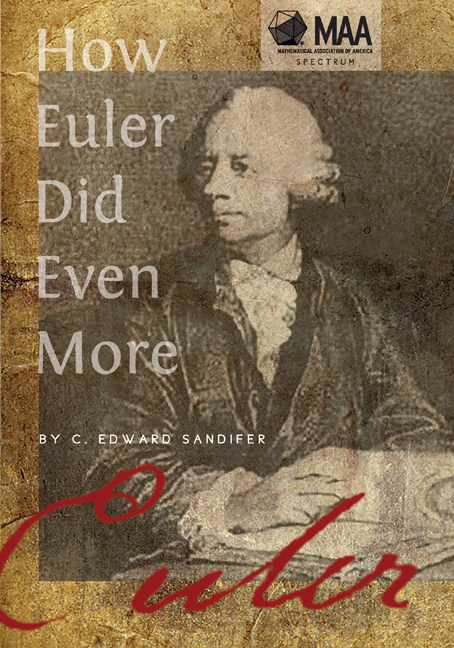Book contents
- Frontmatter
- Contents
- Preface
- Part I Geometry
- Part II Number Theory
- Part III Combinatorics
- Part IV Analysis
- Part V Applied Mathematics
- 26 Density of Air (July 2009)
- 27 Bending Light (August 2009)
- 28 Saws and Modeling (November 2008)
- 29 PDEs of Fluids (September 2008)
- 30 Euler and Gravity (December 2009—A Guest Column by Dominic Klyve)
- Part VI Euleriana
- About the Author
26 - Density of Air (July 2009)
from Part V - Applied Mathematics
- Frontmatter
- Contents
- Preface
- Part I Geometry
- Part II Number Theory
- Part III Combinatorics
- Part IV Analysis
- Part V Applied Mathematics
- 26 Density of Air (July 2009)
- 27 Bending Light (August 2009)
- 28 Saws and Modeling (November 2008)
- 29 PDEs of Fluids (September 2008)
- 30 Euler and Gravity (December 2009—A Guest Column by Dominic Klyve)
- Part VI Euleriana
- About the Author
Summary
Leonhard Euler did an immense amount of work in optics, but that work is not very well known among mathematicians. Seven volumes in Series III of the Opera omnia are devoted to Euler's optics, two volumes to his 1769 book the Dioptricae and five volumes containing the 56 papers he wrote on the subject. All but six of those papers were published during Euler's lifetime, evidence of how important his work was considered at the time. Several of Euler's Letters to a German Princess were devoted to optics as well.
The two volumes of the Dioptricae and the 56 papers fill 2522 pages of the Opera omnia. By comparison, Euler's work on number theory consists of 96 papers, no books, taking up 1955 pages in four volumes of Series I of the Opera omnia.
One of Euler's earliest optics papers is also one of his best known, Nova theoria lucis et colorum, “A new theory of light and color” [E88] in which he criticized Isaac Newton's “projectile” theory of light, whereby luminous sources emitted streams of rapidly moving corpuscles and proposed instead that light was rather like sound. Just as sound is a disturbance transmitted by waves in the air, so also, Euler suggested, light is a disturbance in the aether, which Euler and the other scientists of his times believed was a subtle substance filling the universe. [Sandifer Feb 2008] Euler was one of the first to propose a wave theory of light, and his theory was quite influential up until the time of Einstein. [Hakfoort 1995, Home 2007]
The Dioptrica is a textbook on optics that leads the reader through the theory of refraction and the function of lenses and how to use the theory to design telescopes and microscopes. Except for being written in Latin and having no problem sets at the end of each chapter, it is much like a modern text on the subject.
Information
- Type
- Chapter
- Information
- How Euler Did Even More , pp. 175 - 179Publisher: Mathematical Association of AmericaPrint publication year: 2014
